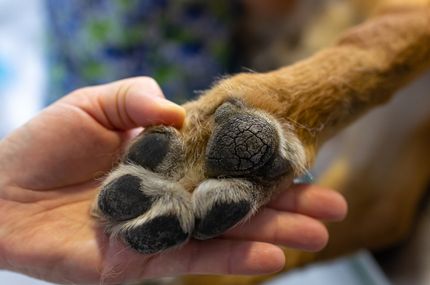Facts & Origin
Cocker Sheltie - The harmonic combination of Cocker Spaniel and Shetland Sheepdog
The Cocker Sheltie is an enchanting blend of the Cocker Spaniel and the Shetland Sheepdog. Both breeds have fascinating origins and a long history. The fusion of these two breeds creates a dog with unique characteristics and traits.
Suitability and attitude
The Cocker Sheltie is suitable for a variety of living situations. Here are some areas in which he can prove himself:
- Family dog: the Cocker Sheltie is an ideal family dog that gets along well with children and can be a gentle companion for the whole family.
- Active Companion: Because of its energy and willingness to play, the Cocker Sheltie is well suited for active people who like to spend time outdoors and involve their dog in various activities.
- Therapy Dog: Due to its friendly nature and adaptability, the Cocker Sheltie can also be used as a therapy dog to bring joy and comfort to people.
| Alternate Name | - |
| Origin | England - Scotland |
| Life expectancy | 10 - 17 years |
| Care requirements | high-maintenance |
| Activity level | average - high |
| FCI group | not recognised |
| AKC group | not recognised |
| KC group | not recognised |
More Cocker Spaniel mixes
More Shetland Sheepdog mixes
Attitude, character and temperament of the breed
Possible character traits of the Cocker Sheltie
The Cocker Sheltie is known for its lovable and even-tempered personality. Here are some character traits he could probably have:
- Friendly and adaptable: The Cocker Sheltie is usually friendly towards people and other animals. He adapts well to different environments and lifestyles.
- Intelligent and eager to learn: with the combination of Cocker Spaniel and Shetland Sheepdog, the Cocker Sheltie is intelligent and quick to learn new commands. He looks forward to being mentally challenged.
- Playful and Active: The Cocker Sheltie is a playful dog who enjoys spending time outdoors and participating in a variety of activities. He enjoys walks, games and interactive challenges.
- Family Oriented: The Cocker Sheltie often shows a strong bond with his family and is a loving companion. He does well with children and other pets when properly socialized.
The Cocker Sheltie is a delightful blend of the Cocker Spaniel and the Shetland Sheepdog. With its lovable character, attractive appearance and adaptability, it makes a wonderful companion for active families and dog lovers. With loving care, training and regular vet visits, the Cocker Sheltie will become a loyal and happy family member.
Usage
Health and care
The Cocker Sheltie is generally a healthy dog, but may inherit certain genetic health problems from the parent breeds. Regular veterinary examinations and a balanced diet are important to maintain his health. Here are some grooming considerations that should be taken care of:
- Coat Care: The Cocker Sheltie often has a long, silky coat that requires regular brushing to prevent matting and keep the coat healthy and shiny.
- Ear Care: Since dogs with droopy ears are prone to ear infections, the Cocker Sheltie's ears should be cleaned regularly and checked for signs of infection.
- Dental Hygiene: Regular dental care is important to prevent dental problems. Daily tooth brushing and regular checkups with the veterinarian are recommended.
What does this mixed breed look like?
The Cocker Sheltie often combines the charming appearance of both parent breeds. Here are some typical characteristics he might likely have:
- Size: the Cocker Sheltie is usually of medium size and has a well-proportioned stature.
- Coat: The coat is often dense, silky, and may be a variety of colors, such as brown, black, sable, or a combination thereof.
- Build: The Cocker Sheltie has an elegant build with an upright posture and a gentle expression.
| Fur length | medium - long |
| Fur | wavy - flat coated |
| Ear shape | Floppy Ear - Tilt-ear |
| Tail | fanned out |
| Anatomy | dainty, sporty |
| Size ♀ | 33 - 41 cm |
| Weight ♀ | 6 - 15 kg |
| Size ♂ | 33 - 43 cm |
| Weight ♂ | 6 - 16 kg |
| Suitable For | - |
Known Diseases
Epilepsy
Definition: Dog has epilepsy if, for example, at least two epileptic seizures occur more than 24 hours apart.
Progressive Retinal Atrophy (PRA)
Progressive retinal atrophy (PRA) is a slowly progressive death of the retina in dogs.
MDR1 defect
The MDR1 defect is a defect in the MDR1 gene that can occur in some breeds of dogs and in humans. This results in the deficient or absent synthesis of a certain protein which is an important component of the blood-brain barrier, leading to hypersensitivity to some drugs.
Eye diseases
Often occur with allergies and intolerances.
FAQ
-
This mixed breed tends to be energetic, loving, hardworking and intelligent. They are also known to form close bonds with their owners and are very adaptable.
-
Life expectancy averages 10 to 14 years.
-
A Cocker Sheltie needs a high-quality, balanced diet high in protein and fat to stay healthy and energetic.
-
He needs at least half an hour of exercise a day and a daily workout to keep himself mentally and emotionally fit.
-
Yes, this dog will shed more or less depending on the gene dominance of its parent.





















